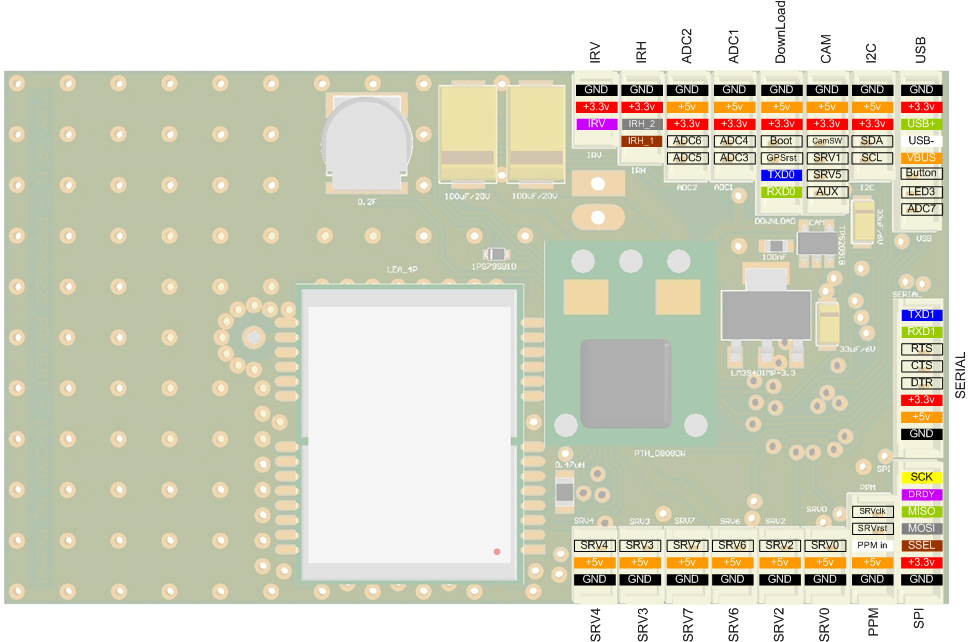Difference between revisions of "Tiny v2"
Jump to navigation
Jump to search
| Line 36: | Line 36: | ||
{|border="1" cellspacing="0" style="text-align:center" cellpadding="6" | {|border="1" cellspacing="0" style="text-align:center" cellpadding="6" | ||
|+'''SERIAL''' | |+'''SERIAL''' | ||
!''Pin #''!!''Name''!!''Type''!!''Description | !''Pin #''!!''Name''!!''Type''!!''Description''!!width="50"|''Suggested Color'' | ||
|- | |- | ||
|1||GND||PWR||common ground | |1||GND||PWR||common ground||style="background:black; color:white"|Black | ||
|- | |- | ||
|2|| +5V||PWR||5V Rail from Tiny | |2|| +5V||PWR||5V Rail from Tiny||style="background:Orange; color:white"|Orange | ||
|- | |- | ||
|3|| +3.3V||PWR||3.3V Rail from Tiny | |3|| +3.3V||PWR||3.3V Rail from Tiny||style="background:Red; color:white"|Red | ||
|- | |- | ||
|4||DTR | |4||DTR|| || || | ||
|- | |- | ||
|5||CTS | |5||CTS|| || || | ||
|- | |- | ||
|6||RTS | |6||RTS|| || || | ||
|- | |- | ||
|7||RXD1||IN||UART1 Serial Input (5V Tolerant) | |7||RXD1||IN||UART1 Serial Input (5V Tolerant)||style="background:green; color:white"|Green | ||
|- | |- | ||
|8||TXD1||OUT||UART1 Serial Output (5V Tolerant) | |8||TXD1||OUT||UART1 Serial Output (5V Tolerant)||style="background:blue; color:white"|Blue | ||
|} | |} | ||
Revision as of 11:03, 9 December 2007
Features
- Single LPC2148 MCU
- 8 Analog input channels 0V - 3.3V (2 channels with optional on-board 5v -> 3.3v resistor bridge)
- 1 3.3V TTL UART (5V tolerant)
- 8 PWM outputs
- 1 R/C receiver PPM frame input
- 1 SPI bus
- 1 I2C bus
- 1 USB (client)
- Integrated GPS receiver and patch antenna (4Hz update)
- 5V/2.5A switching power supply & 3.3V/1A linear regulator
- 3 status LEDs with attached test point
- ?? grams
- 70.8 x 40mm (smaller then a banking card)
- 2 layers PCB design, 0603 components
The Tiny v2.1 autopilot uses a single Philips LPC2148 ARM7 based microcontroller. The ARM7 is a low-power 32-bit RISC processor core and the Philips LPC2148 has 512KB on-chip Flash ROM, 40KB RAM and can be clocked at 60MHz.
Although critical control code such as the R/C interface and servo output are well segregated in Paparazzi software and well protected from interference from flaws in the stability/navigation/comm/payload code, great care must be taken when experimenting with new software as some errors can cause a the processor to halt or stall for extended periods causing total loss of control.
Architecture
Pinout
Pins Name and Type are specified with respect to the Autopilot Board
| Pin # | Name | Type | Description | Suggested Color |
|---|---|---|---|---|
| 1 | GND | PWR | common ground | Black |
| 2 | +5V | PWR | 5V Rail from Tiny | Orange |
| 3 | +3.3V | PWR | 3.3V Rail from Tiny | Red |
| 4 | DTR | |||
| 5 | CTS | |||
| 6 | RTS | |||
| 7 | RXD1 | IN | UART1 Serial Input (5V Tolerant) | Green |
| 8 | TXD1 | OUT | UART1 Serial Output (5V Tolerant) | Blue |


